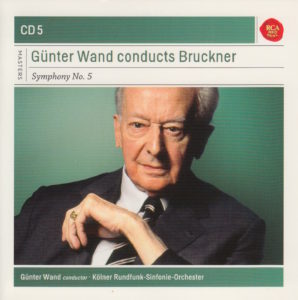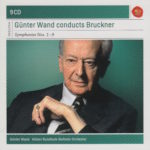 Today is the last day for me to listen to Bruckner’s Fifth.
Today is the last day for me to listen to Bruckner’s Fifth.
Tomorrow starts a brand new symphony, Bruckner’s Sixth.
But that’s tomorrow.
This morning’s conductor of Anton Bruckner’s Symphony No. 5 in B-Flat Major (WAB 105) – nicknamed “Tragic,” “Church of Faith,” or “Pizzicato” symphony (for reasons I’m still discovering) – is German-born Gunter Wand (1912-2002).
Maestro Wand’s name had come up a time or two when I read reviews of Bruckner’s symphonies. He was looked upon favorably by most Brucknerians. So, when I first started this journey – back on October 3rd – Wand was one of the conductors I most looked forward to hearing.
And hear him I did on Day 16 (Symphony No. 1).
Then, on Day 32 (Symphony No. 2).
 And again on Day 48 (Symphony No. 3).
And again on Day 48 (Symphony No. 3).
And again on Day 64 (Symphony No. 4).
And again, most recently, on Day 67 (Symphony No. 5, in the Bruckner Collection box set).
NOTE: Today will be the second time I’ll hear Gunter Wand conduct Bruckner’s Fifth. He is the only conductor in my project who holds that distinction.
First, the objective aspects of this recording:
Bruckner’s Symphony No. 5 in B-Flat Major (WAB 105) composed in 1875-1876
Gunter Wand conducts
Wand used the ??? version, edited by ??? (unknown)
Kolner Rundfunk-Sinfonie-Orchester plays
The symphony clocks in at 74:16
This was recorded at Klaus-von-Bismarck-Saal in Cologne, Germany, in 1974
Wand was 62 when he conducted it
Bruckner was 51 when he finished composing it
This recording was released on the RCA/Red Seal label
Even though no version or editor of the version is included in this box set (and why not, people? Is that asking too much?), according to the entry on Wikipedia,
1878 version
This is the version normally performed. It exists in editions by Robert Haas (published 1935) and Leopold Nowak (published 1951) which are almost identical.
So that’s my guess as to what Wand used. But was it Haas? Or Nowak? I really shouldn’t have to guess, now, should I?
Bruckner wrote his symphonies in four parts. The time breakdown of this one (Symphony No. 5 in B Flat Major, version unknown), from this particular conductor (Wand) and this particular orchestra (Kolner Rundfunk-Sinfonie-Orchester) is as follows:
I. Introduction (Adagio) — Allegro. B-flat major……………………………20:08
II. Adagio. Sehr langsam. (Very slowly) D minor……………………………15:48
III. Scherzo. Molto vivace D minor…………………………………………………14:12
IV. Finale (Adagio) — Allegro moderato. B-flat major…………………..24:08
Total running time: 74:16
Okay. Now, here are the subjective aspects:
My Rating:
Recording quality: 3
Overall musicianship: 4
CD liner notes: 0 (there aren’t any – shame on them!)
How does this make me feel: 3
The excitement I heard in yesterday’s recording (Day 79, Georg Tintner conducting) isn’t in this one.
For one thing, I don’t like how it sounds. There doesn’t seem to be a lot of depth to this recording, no space between the instruments. Oh, I can hear every one. That’s not the issue. For me, it’s that the instruments seem to peak at the same level and then kind of become indistinct from one another.
I know that’s really hard to understand.
But here’s an analogy: AM radio vs. FM radio.
AM radio has a problem replicating highs and lows. It all comes out as a kind of imprecise mid range. FM radio, on the other hand, can reproduce a wider range of sounds with clarity.
Again, I’m not saying there’s anything wrong with this recording. It was recorded well, played well, and mastered well.
This opinion is strictly in my ears, how I’m hearing it.
It’s this kind of mid-range indistinctness that’s the reason why the entire symphony doesn’t electrify me. I can hear mastery. I can hear energy. I can hear all sorts of skill.
But I’m on the outside looking in, not part of it. Not drawn in.
Even the Finale kind of leaves me cold.
But, as I’ve written countless times before, your mileage may vary.
